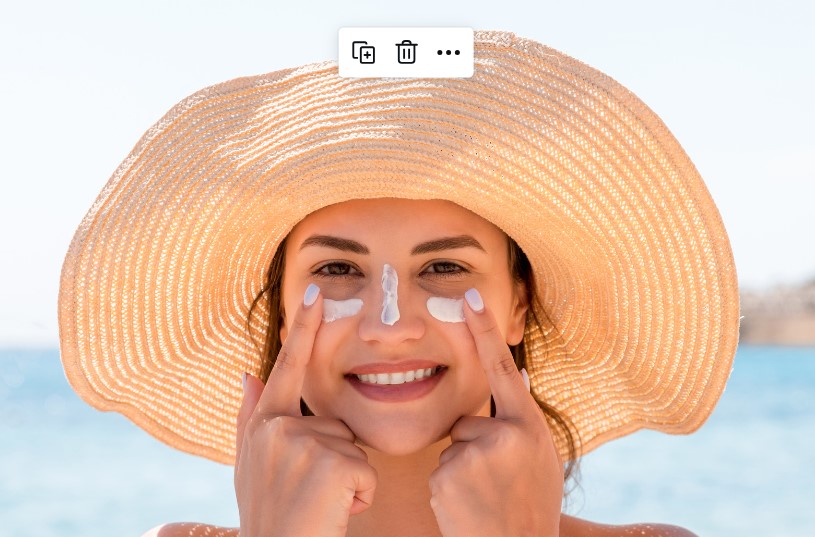
How to get rid of sunspots
Sunspots are caused by prolonged sun exposure. Effective prevention and treatment methods can help fade these dark spots and maintain an even skin tone.
We’ll highlight some of the best ways to remove sunspots, how to care for your skin post-treatment, and provide tips on preventing them. Restore your skin to its former glory and bring back your confidence.
Quick links:
What are sunspots?
Sunspots, also known as liver spots, age spots, or brown spots, are small, dark patches that appear on the skin, particularly in areas frequently exposed to the sun. These spots are usually harmless and develop due to an overproduction of melanin, the pigment responsible for skin color. Sunspots are more common in people with fair skin, but they can affect all skin types.
Sunspots often appear as flat, oval-shaped patches with a smooth texture and can range in color from light brown to black. They are usually painless and do not have irregular borders, which helps distinguish them from potentially cancerous spots like melanoma. While sunspots do not pose a significant health risk, many people choose to remove or fade them for cosmetic reasons, as they can be unsightly and make the skin look older or uneven.
What causes sunspots?
The primary cause of sunspots is prolonged exposure to ultraviolet (UV) radiation from the sun or artificial sources sucha s tanning beds. When your skin is exposed to UV light, it triggers an increase in the production of melanin as a defense mechanism to protect the deeper layers of skin from damage. Over time, this can lead to an accumulation of melanin in certain areas, resulting in the appearance of sunspots.
Other factors that can contribute to the development of sunspots include:
- Aging. As we age, our skin becomes less efficient at regenerating and repairing itself. It becomes more susceptible to sun damage and the formation of sunspots.
- Skin type. People with fair skin are more prone to developing sunspots because they have less natural protection against UV radiation than those with darker skin tones.
- Hormonal changes. Hormonal fluctuations, such as those experienced during pregnancy or menopause, can stimulate melanin production and increase the likelihood of sunspots appearing on the skin.
- Certain medications. Some medications, such as antibiotics, diuretics, and non-steroidal anti-inflammatory drugs (NSAIDs), can make the skin more sensitive to UV light and increase the risk of sunspots.
How to remove sunspots?
Several at-home and professional treatments can lessen or remove sunspots.
Home treatments
These are some home treatments that may help fade or remove sunspots on your skin:
- Aloe vera. Aloesin and aloin, active compounds in aloe vera plants, may help fade sunspots and other forms of hyperpigmentation.
- Licorice extract. Certain active ingredients found in licorice extract could assist in lightening sunspots and other skin discoloration worsened by sun exposure. Such as melasma, which often occurs in pregnant women and is known as "the mask of pregnancy." Many topical creams designed for lightening sunspots contain licorice extract.
- Vitamin C. This natural antioxidant offers several skin benefits when it comes to sun protection. Topical L-ascorbic acid shields your skin from UVA and UVB rays, stimulates collagen production, and is effective in lightening dark spots.
- Vitamin E. A diet rich in vitamin E and vitamin E supplements can help protect against sun damage and improve your skin's overall health, particularly when combined with vitamin C. Applying vitamin E oil directly to the skin can have even greater benefits in protecting against sun damage and may aid in fading sunspots.
- Apple cider vinegar. Acetic acid, a component of apple cider vinegar, may help lighten skin pigmentation and enhance the overall appearance of your skin.
- Black tea water. A study from 2011 discovered that black tea water, when applied twice daily for six days a week over four weeks, had a skin-lightening effect on tanned spots on guinea pigs.
- Red onion. According to a study published in 2011, dried red onion skin contains ingredients that could lighten the skin.
- Lemon juice. Lemon juice has been used as a traditional home remedy for lightening hair and skin, and is a frequent ingredient in skin-lightening creams. While many people swear by lemon juice's ability to fade sunspots, it is acidic and can cause dryness, as well as irritate the skin and eyes.
- Buttermilk. The lactic acid found in buttermilk may help lighten sunspots when applied to the skin.
- Milk. Like buttermilk, milk is high in lactic acid, which may help lighten sunspots. Sour milk is effective in treating skin discoloration.
- Honey. Honey has antioxidant properties and has been used in skin products for years. It is believed to promote new cell growth and may help fade sunspots when applied to the skin.
- Over-the-counter creams. OTC topical creams are available that you can apply at home to remove sunspots on your face. Look for creams containing glycolic acid, hydroxy acid, kojic acid, or deoxyarbutin.
Professional treatments
There are a few professional treatments that can help with removing or lessening sunspots. Here are some of the treatment options you can choose:
- Laser resurfacing
- ILP
- Cryotherapy
- Chemical peels
- Microdermabrasion
Laser resurfacing
This technique utilizes a wand-like device that emits beams of light to eliminate sun-damaged skin layer by layer, allowing new skin to grow in its place. Laser resurfacing on the face can take from 30 minutes to two hours, depending on the number of sunspots being treated. The healing process typically takes 10 to 21 days.
Intense pulse light (IPL)
IPL employs pulses of light energy to target sunspots on the skin by heating and destroying the melanin, resulting in the removal of discolored spots. An IPL session usually lasts less than 30 minutes and causes minimal to no pain. The number of sessions required is different from person to person.
Cryotherapy
This method removes sunspots and other skin lesions by freezing them off using a liquid nitrogen solution. For the treatment of superficial dark spots like sunspots, nitrous oxide may be used instead of liquid nitrogen, as it is less aggressive and less likely to cause blistering. Cryotherapy takes only a few minutes and is generally well-tolerated.
Chemical peels
This procedure involves applying an acid solution to the skin and creating a controlled wound that eventually peels off. This allows new skin to grow. Chemical peels can be painful and cause a burning sensation lasting a few minutes. The pain can be managed with cold compresses and over-the-counter pain medication.
Microdermabrasion
This treatment involves gently removing the outermost layer of your skin using a special applicator with an abrasive tip, followed by suction to remove the dead skin. Microdermabrasion takes approximately one hour, causes little to no pain, and doesn't require anesthesia. After the treatment, your skin will be pink and feel tight, but these effects are temporary.
How to care for your skin after the treatment?
Proper care is important after any medical treatment. Here are some essential tips for post-treatment skin care:
- Sun protection. Protect your treated skin from further sun damage with broad-spectrum sunscreen with an SPF of at least 30 daily. Wear protective clothing, such as wide-brimmed hats and long-sleeved shirts, and avoid direct sun exposure, especially during peak hours.
- Gentle cleansing. Use a mild, fragrance-free cleanser to wash your face twice daily. Avoid harsh scrubs or exfoliants that can irritate your sensitive skin after the treatment.
- Moisturize. Apply a lightweight, non-comedogenic moisturizer to keep your skin hydrated and support the healing process. Look for products that contain soothing ingredients such as aloe vera, chamomile, or ceramides.
- Avoid irritants. Steer clear of skincare products that contain alcohol, retinoids, or alpha-hydroxy acids (AHAs) in the days following your treatment. These ingredients can cause further irritation and lead to dry skin. Also, avoid using chemical sunscreens as they may exacerbate skin sensitivity and cause discomfort on recently treated skin.
- Cool compresses. If you experience redness, swelling, or discomfort after the treatment, apply cool compresses to the affected areas for relief.
- Don't pick or scratch. Resist the temptation to pick or scratch at any peeling or flaking skin, as this can lead to scarring and prolong the healing process. Allow the skin to heal naturally.
- Follow-up appointments. Attend any scheduled follow-up appointments with your dermatologist to monitor your skin's healing progress and address any concerns you may have.
When to see a dermatologist
While many sunspots can be treated effectively with at-home remedies or over-the-counter products, there are instances when you should consult a board-certified dermatologist.
Here are some situations when you should seek professional help:
Ineffective treatments
If you've been using over-the-counter products or home remedies consistently for several weeks without seeing any improvement in your sunspots, it may be time to consult a dermatologist. They can recommend more effective treatment options tailored to your specific needs.
Unusual changes in sunspots
If you notice any changes in the size, shape, color, or texture of your sunspots, such as irregular borders or rapid growth, schedule an appointment with a dermatologist. These changes could be a sign of a more serious skin condition, such as skin cancer.
Painful or irritated sunspots
If your sunspots become painful, itchy, or inflamed, or if they start to bleed or ooze, see a dermatologist as soon as possible. These symptoms may indicate an infection or an adverse reaction to a product you've been using.
Extensive or widespread sunspots
If you have a lot of sunspots covering a large area of your skin, a dermatologist can help you develop a comprehensive treatment plan to address them effectively.
Concerns about skin health
If you have a family history of skin cancer or are concerned about the overall health of your skin, it's always a good idea to schedule regular check-ups with a board-certified dermatologist. They can perform thorough skin exams, monitor your sunspots, and provide guidance on maintaining healthy skin.
Persistent dead skin cells
If you notice an accumulation of dead skin cells or flaking skin that doesn't improve with regular exfoliation or moisturizing, a dermatologist can help identify the underlying cause and recommend an appropriate treatment. In some cases, persistent dead skin cells may be a sign of an underlying skin condition that requires professional attention.
Protect your skin with quality swimwear
Stop sun spots, sun poisoning, and other forms of ultraviolet skin damage with UPF 50 fabric.
We offer functional and fashionable sun-safe clothing that will keep your skin protected from harmful UV rays and help prevent sunspots. You will find many styles and sizes in our collections, so you can get the right fit and feel for every member of the family.
Check out some of our popular collections:
Sunspots FAQ
Can sunspots be removed?
Sunspots can be removed or significantly faded using different treatments. Options include topical creams containing hydroquinone, kojic acid, or retinoids, as well as professional treatments like chemical peels, laser therapy, and cryotherapy. The effectiveness and duration of treatment depends on the size, depth, and color of the sunspots.
Why do I keep getting sunspots?
Sunspots develop due to long-term sun exposure, which causes the skin to produce excess melanin as a defense mechanism. If you continue to expose your skin to UV rays without proper protection, you may keep getting sunspots. Other factors (age, genetics, and certain medications) can also increase sunspot formation.
Do sunspots get back after laser treatment?
While laser treatments can remove existing sunspots, they do not prevent new ones from forming. If you continue to expose your skin to UV rays without adequate protection, new sunspots may develop over time. Maintenance treatments and consistent sun protection are essential to minimize the recurrence of sunspots.
Does hydrogen peroxide get rid of age spots?
Hydrogen peroxide is not recommended for use on the skin to treat age spots. It can cause skin irritation, and redness, and potentially worsen skin conditions. Safer and more effective alternatives include over-the-counter products containing ingredients such as retinol, vitamin C, and glycolic acid.
Does toothpaste help with brown spots on the face?
Toothpaste is not an effective or recommended treatment for brown spots on the face. While some toothpaste contains abrasive ingredients that may slightly exfoliate the skin, they can also cause irritation, dryness, and further pigmentation issues. Stick to proven topical treatments or consult a dermatologist for safe and effective options.
What is the fastest way to get rid of age spots at home?
The fastest way to get rid of age spots at home involves using over-the-counter products containing active ingredients such as retinol, vitamin C, azelaic acid, glycolic acid, and kojic acid. These ingredients can reduce melanin in the skin, lightening age spots.
Will retinol lighten dark spots?
Retinol can lighten dark spots. It works by promoting cell turnover and reducing the production of melanin, which in turn lightens hyperpigmentation and age spots. Consistent use of retinol-containing products can lead to visible improvements in skin tone and texture.
What is the difference between age spots and sunspots?
Age spots and sunspots refer to the same condition, known medically as solar lentigines. These are flat, brown spots on the skin caused by prolonged exposure to ultraviolet (UV) rays from the sun. They are more common in people with fair skin and those older than 40.
Further reading
Resources
Tyrosinase inhibitory effect of quercetin 4′-O-β-D-glucopyranoside from dried skin of red onion (Allium cepa). (2011, November 25). Taylor & Francis Online. https://www.tandfonline.com/doi/abs/10.1080/14786411003754256?src=recsys&journalCode=gnpl20
Whitening Effect of Black Tea Water Extract on Brown Guinea Pig Skin. (2011, September 27). NCBI. https://www.ncbi.nlm.nih.gov/pmc/articles/PMC3834380/



Leave a comment
This site is protected by hCaptcha and the hCaptcha Privacy Policy and Terms of Service apply.